2. 南京信息工程大学气象灾害预报预警与评估协同创新中心, 气象灾害教育部重点实验室, 南京 210044;
3. 中国科学院东北地理与农业生态研究所, 长春 130102
2. Key Laboratory of Meteorological Disaster, Ministry of Education(KLME), Collaborative Innovation Center on Forecast and Evaluation of Meteorological Disasters(CIC-FEMD), Nanjing University of Information Science & Technology, Nanjing 210044, China;
3. Northeast Institute of Geography and Agroecology, Chinese Academy of Sciences, Changchun 130102, China
PM2.5是大气颗粒物中空气动力学直径≤2.5 μm的粒子, 在大气中停留时间长、传输距离远[1], 因其对人体健康、全球辐射平衡等具有重要影响而受到广泛关注[2, 3].有机气溶胶是PM2.5的重要组成部分, 占PM2.5质量的20%~60%, 其成分、来源非常复杂, 对人体有长期毒性、致癌性、致畸性[4, 5], 是大气环境科学研究的重点和难点[6].
有机气溶胶中包含一些非极性有机化合物, 比如正构烷烃(n-alkanes)、多环芳烃(polycyclic aromatic hydrocarbons, PAHs)和藿烷类化合物(hopanes)等, 它们主要来自于人为排放源和生物质排放源的一次排放和二次转化生成, 可作为有机分子标记物用于指代大气颗粒物中的特定污染源(燃煤、生物质燃烧和机动车尾气等)[7].近年来, 国内外许多学者对有机分子标记物进行了广泛研究[8, 9], 结果表明正构烷烃可当做化石燃料利用和生物源排放的标记物[10]; 多环芳烃作为由化石燃料不完全燃烧形成的半挥发性有机化合物, 特征比例可作为某些燃烧源优势的定性指标[11]; 藿烷类化合物是燃料油、煤和润滑剂的生物标记物, 可以用来识别机动车排放源[12].此外, 左旋葡聚糖(levoglucosan)作为纤维素高温热解的产物, 因为其来源单一、稳定性强而被广泛用于生物质燃烧示踪[13, 14].但国内的研究主要集中在重点城市地区如京津冀、长江三角洲、珠江三角洲等地, 对其它地区有机气溶胶的相关研究相对较少, 尤其是有机化合物的组分特征及来源研究亟待加强.
吉林省作为东北三省之一, 近年来因秸秆焚烧事件和采暖措施等引起的严重空气质量问题受到国内外科学工作者的广泛关注.目前针对吉林省PM2.5污染特征的研究主要集中在重金属[15, 16]和水溶性无机离子[17, 18]方面, 多环芳烃等有机化合物组分及来源差异的相关研究为之甚少[19~21].本研究对2016年10~11月期间在长春城郊采集的PM2.5样品中的OC、EC、左旋葡聚糖以及三类非极性有机化合物(正构烷烃、多环芳烃和藿烷类化合物)进行定量检测, 讨论了化合物的浓度水平和时间变化特征, 用分子标记物、特征比值法探讨了PM2.5的来源, 并用主成分分析结合多元线性回归模型给出了不同来源对PM2.5的相对贡献, 以期为该地区环境治理提供基础研究方向.
1 材料与方法 1.1 研究区域与样品的采集长春市是吉林省的省会城市, 是全省经济、政治、文化中心, 全市面积达20 604 km2.该市有着典型的半湿润大陆性季风气候, 春秋两季干燥多风, 夏季短且湿热, 冬季漫长干冷.年平均气温5.7℃, 年平均湿度为65%, 年平均降雨量为650 mm, 年平均风速达3.6 m·s-1 [22].长春市每年的供暖时间是从10月25日至次年4月10日, 采暖时间长, 全年达到155 d.在大气稳定度方面, 采暖期较非采暖期稳定天气出现多, 且更易出现不利于环境污染物扩散的逆温天气.
采样点设置在长春市城郊的中国科学院东北地理与农业生态研究所(125.4°N, 44.0°E)(图 1), 样品采集使用大流量PM2.5采样器(武汉天虹), 从2016年10~11月连续采集, 采样时间24 h, 采样流量为1.05 m3·min-1, 共采集到40个样品.此外, 采集2个野外空白样品用于空白校正.本研究选用石英滤膜采集颗粒物样品, 采样前将滤膜用锡纸包好, 在马弗炉中450℃焙烧6 h, 以去除滤膜上其他有机物质, 冷却至室温后放到干燥皿里衡重平衡48 h, 在相对湿度和温度保持稳定的条件下用微电子天平(BS124S, 德国SARTORIUS)加以称重, 最后放在-24℃的冰箱中待测.
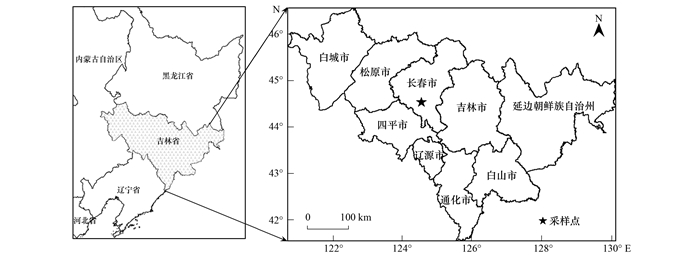
|
图 1 长春城郊采样地点示意 Fig. 1 Sampling site in the suburb of Changchun |
有机碳(organic carbon, OC)和元素碳(elemental carbon, EC)用美国Sunset Lab公司Model-4型全自动半连续式分析仪采用NIOSH程序[23]加以测定.测量原理是热光透射法, 即在测定过程中用一束激光来检测滤膜对该激光的响应信号, 用以确定OC与EC的分界点, 从而校正炭化引起的误差.定量的氦气/甲烷(He/CH4)标气在每个样品分析结束后都会被通入仪器中, 用CH4标准峰来校正和定量[24].样品测量前后用标准蔗糖溶液对仪器进行校正, 检出限为0.5 μg·m-3.
非极性有机化合物(non-polar organic compounds, NPOCs)在热脱附(TD)联用的安捷伦气相色谱质谱仪(GC7890B/MS5977A)中进行分离和检测.与传统有机萃取法相比, 有效地避免了预处理流程中样品损失和溶剂杂质污染, 提高了样品的检出限.色谱条件为高分离度气相色谱柱(长30 m, 内径0.25 mm, 0.25 μm涂层).取0.14 cm2的滤膜样品放进TD进样口衬管内, 进样口温度35℃, 保持5 s, 然后以12℃·s-1升温到300℃; 柱温35℃, 保持3 min, 然后以10℃·min-1升温到120℃, 再以4℃·min-1升温到146℃, 最后以8℃·min-1升温到310℃, 保持16 min.载气为高纯氦, 流量1.0 mL·min-1, 进样方式为五倍分流进样, 分流比为5:1, 进样量为1 μL.目标化合物通过内标法进行定量, 将六甲基苯作为内标物质, 正构烷烃C10~C36(安谱)、多环芳烃与藿烷各混标(Sigmal-Aldrich; 美国)混合配成0.1、0.2、0.5、1、2、5、10和15 μg·mL-1不同浓度梯度的标准溶液, 绘制成标准曲线, 根据样品中目标化合物与内标的峰面积进行定量.
左旋葡聚糖(levoglucosan)的浓度是采用离子色谱仪(ICS 5000+, Thermo Scientific)配备250 mm MA1分析柱和50 mm MA1保护柱进行测定, 样品前处理方法为:取两片直径为18 mm的滤膜, 加入20 mL超纯水(Milli-Q Reference, 美国)超声振荡30 min, 用0.22 μm的特氟龙滤膜过滤器将萃取溶液过滤到进样管中待测.将左旋葡聚糖等糖类标准(安谱)配成1、2、5、10、20、50、100、200、500和1 000 μg·L-1不同浓度梯度的混合标准溶液, 绘制成标准曲线对样品中目标化合物进行定量.
1.3 质量控制与质量保证(QA/QC)采样前需清洗切割头并校准采样流量, 采样过程中每5 d清洗一次切割头; 实验过程中使用的镊子、剪刀和打孔器等均用二氯甲烷:甲醇(2:1, 体积比)的溶剂浸润过的脱脂棉擦拭干净; 玻璃器皿(包括细胞瓶、菌种瓶等)都先用超纯清洗器以超声清洗45 min, 烘干后再放入马弗炉中450℃焙烧4 h, 以去除瓶子本身残留的有机物质.
参考美国环境保护署EPA方法, 进行了实验室空白、试剂空白、野外空白和回收率实验, 并对所有样品数据进行空白校正.各类有机物标准曲线的相关系数达到99.9%以上, 标准曲线满足要求后测样.氘代内标的回收率为70%~120%, 平行样的标准偏差小于15%, 也表明实验结果具有良好的重现性, 满足有机物定量分析的要求.
1.4 主成分分析-多元线性回归(PCA-MLR)模型主成分分析(principal componengt analysis, PCA), 利用“降维”的思想把多个变量经线性变化后筛选出能代表化学元素含量在样品中的绝大部分变化量的几个主成分, 并通过经方差极大旋转后的化学元素主因子载荷来识别排放源的类型[25].多元线性回归(multiple liner regression, MLR)的目的是在排放源识别的基础上, 通过两次最小二乘法确定主要污染源极其贡献率[26].污染源的平均贡献率(A, %)可表示为:

|
(1) |
式中, i指污染源, Bi指污染源i对应的回归系数.
2 结果与讨论 2.1 PM2.5中各组分浓度变化特征本研究中测定的采样期间PM2.5组分包括OC、EC、左旋葡聚糖以及非极性有机化合物(正构烷烃、多环芳烃和藿烷类化合物), 浓度详见表 1.在采样期间, PM2.5浓度范围为(27.2~250.5)μg ·m-3, 均值为(79.0±55.7) μg·m-3(图 2), 是国家环境空气质量(GB 30952012)日平均二级标准浓度限值(75 μg·m-3)的1.05倍.与同时期国内其他城市(上海:0.5倍, 厦门:0.4倍, 南京:0.5倍)相比, 长春地区PM2.5浓度处于较高水平.以二级标准浓度限值来对采样期间污染天气和清洁天气进行划分, 污染天数有13 d, 超标率达33.3%. OC和EC在采样期间的平均质量浓度为(20.7±15.6) μg·m-3和(2.2±1.1) μg·m-3, 分别占PM2.5质量浓度的26.2%和2.8%.污染天气下, OC和EC浓度分别是清洁天气下的3.0和2.1倍.利用OC/EC比值法可以简单判断出该地区的主要污染源[27], 比值为2.5~10.5说明存在生物质燃烧源[28], 1.0~4.2证实有交通源[29], 8.1~12.7则表明有煤燃烧源[30].本研究中OC与EC比值范围为4.2~20.6, 表明采样点附近主要受到生物质燃烧和煤燃烧源的影响, 交通源的贡献最小.此外, OC与EC的相关系数达到了0.7, 说明它们大部分污染源相同或相近[31].左旋葡聚糖的浓度范围为(41.0~1 989.4)ng·m-3, 均值为(449.3±404.5)ng·m-3.最低和最高浓度值分别出现在10月26日和11月3日, 整体浓度变化趋势与OC一致.本研究左旋葡聚糖浓度远高于北京[32]、南京[33]和金华[34]地区的相关结果, 说明生物质燃烧对长春秋季大气细颗粒物的贡献较大.
|
|
表 1 2016年长春秋季PM2.5中各化合物浓度特征值1) Table 1 Concentrations of each compound in PM2.5 in autumn in Changchun, 2016 |
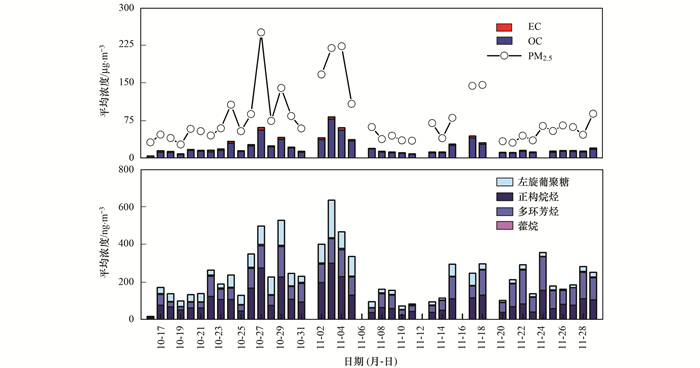
|
图 2 2016年长春秋季PM2.5中各化合物浓度时间变化特征 Fig. 2 Time variation characteristics of each compound concentration in PM2.5 in autumn in Changchun, 2016 |
采样期间PM2.5中共检测到16种正构烷烃, 碳数分布范围为C20~C35(图 3), 浓度范围为0.5~10.4 ng·m-3(表 1), 日均浓度最大值与OC、EC的峰值出现时间一致, 都在11月3日.本研究总定量正构烷烃的平均浓度为(101.3±66.9)ng·m-3, 低于Feng等[35]冬季在上海徐汇(149±107)ng·m-3和青浦(133±35)ng·m-3地区测定的浓度, 更接近北京地区夏季正构烷烃的浓度水平(95.8~132)ng·m-3.
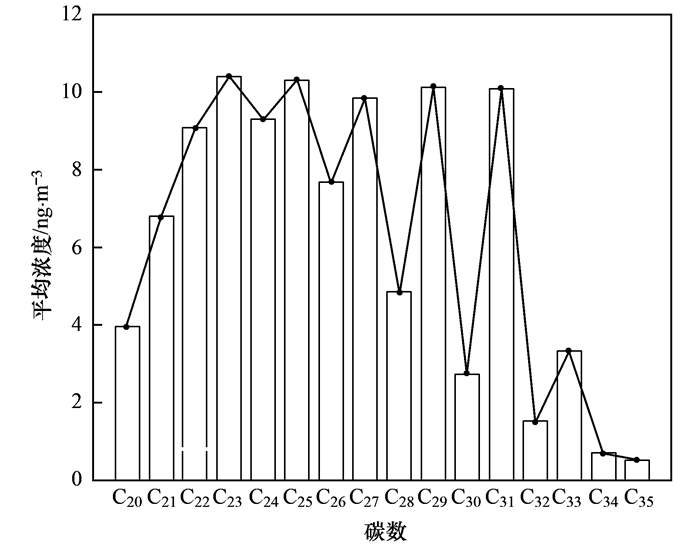
|
图 3 2016年长春秋季PM2.5中正构烷烃的碳数浓度分布特征 Fig. 3 Carbon concentration distribution of n-alkanes in PM2.5 in autumn in Changchun, 2016 |
由图 3可以看出C23的浓度最高, 从C20~C23, 其浓度随着碳原子数的增加而增加; 从C24开始, 正构烷烃的浓度呈锯齿状分布, 高碳数正构烷烃的浓度更高, 奇偶优势分布特征明显.碳优势指数CPI通过计算样品中奇数碳和偶数碳之和的比值, 可对人为源和生物源的相对贡献进行评估[36]. CPI值越高, 说明高等植物蜡等生物源对该地区正构烷烃分布的贡献越大; 反之, 说明正构烷烃主要来自于机动车尾气、化石燃料燃烧或生物质的不完全燃烧等人为源.一般CPI值大于5, 甚至大于10, 表明来自于生物源; CPI值小于等于1, 表明来自于人为源; 介于1~5之间的CPI值则表明正构烷烃来自于混合源, 且随着人为源和生物源相对贡献的大小而不断变动[37, 38].本研究中CPI的均值为1.5, 反映了人为源和生物源对该地区正构烷烃分布的共同影响.
为更好判断出人为源和生物源对长春PM2.5中正构烷烃的相对重要性, 用植物蜡含量来估算由高等植物蜡产生的正构烷烃对总的正构烷烃浓度的贡献率[39].

|
(2) |
式中, WaxCn(%)指植物蜡含量, 该参数假定高碳数的正构烷烃只由植物挥发产生, 选取C27、C29、C31和C33作为生物源的标志物进行WaxCn计算; Cn-1、Cn和Cn+1分别指碳数为n-1、n和n+1的正构烷烃的浓度值.经计算, C27、C29、C31和C33的植物蜡含量值分别为35.1%、57.8%、69.0%和52.1%, 平均值为53.5%, 说明长春地区大气气溶胶中正构烷烃受生物源的影响比较大.
2.3 多环芳烃大气中多环芳烃主要是由煤、石油等化石燃料以及木材、烟草等含碳氢化合物不完全燃烧或热解所形成的[40, 41].本研究中一共测得了15种多环芳烃,单体的平均浓度范围为0.5~11.7 ng·m-3,具体组分含量见表 1.从图 4可以看出,中环多环芳烃(Flua、Pyr、BaA和Chr)的平均质量浓度与低环多环芳烃(Phe和Ant)的浓度相比较高,但略低于高环多环芳烃如BbF+BkF、BaP+BeP的浓度值. BbF+BkF、Flua、Pyr以及BaP+BeP占主要地位,其次是BaA、BghiP等.质量浓度高低顺序为BbF+BkF(13.9 ng·m-3)>Flua(10.9 ng·m-3)>Pyr(10.7 ng·m-3)>BaP+BeP(10.6 ng·m-3),占比分别为17.0%、13.4%、13.1%和13.0%.
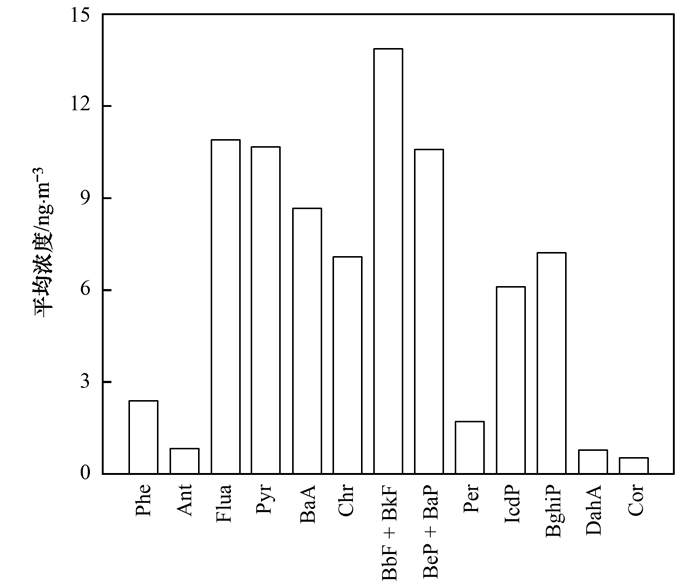
|
图 4 2016年长春秋季PM2.5中多环芳烃单体的平均浓度分布 Fig. 4 Average concentration distribution of PAHs in PM2.5 in autumn in Changchun, 2016 |
为确定多环芳烃的来源,本研究使用分子诊断率进行计算,得到实际值与文献的参考值对比见表 2.本研究中IcdP/(IcdP+BghiP)比值范围为0.3~0.5,表明该地区的多环芳烃主要来自于石油燃烧源,而BaA/(BaA+Chr)比值范为0.4~0.6,体现了机动车尾气排放的贡献. Flua/(Flua+Pyr)与(BaP+BeP)/BghiP的比值范围分别为0.46~0.54和1.2~1.7,进一步确认了交通源的存在,另外,Flua/(Flua+Pyr)比值结果还证明了草、木等生物质燃烧源和煤燃烧源的贡献.综上,该地区秋季多环芳烃主要来自于煤燃烧源,生物质燃烧源以及交通源.
|
|
表 2 2016年长春秋季PM2.5中多环芳烃的平均诊断率 Table 2 Average diagnostic rate of PAHs in PM2.5 in autumn in Changchun, 2016 |
2.4 藿烷类化合物
藿烷类化合物是地质体中丰度最高的一类生物标志物, 其物化性质特别稳定, 一般条件下不会发生降解反应, 可用作化石燃料燃烧源的分子标记物[12, 46].本研究中共定量分析了6种藿烷类化合物, 总浓度范围为0.8~7.1 ng·m-3, 其中30ab的含量最高, 其次是31abR, 平均浓度分别是1.0 ng·m-3和0.8 ng·m-3, 其它组分含量详见表 1.
升藿烷的异构化指标[定义为31abS/(31abS+31abR)]是用来判断其来源的一个重要参数, 本研究升藿烷的异构化指标均值为0.5, 与褐煤(0.1)和烟煤(0.4)等燃煤源产生的藿烷比值相比, 更接近矿物油衍生的排放源(如机动车排气尾管)比值(0.57~0.59)[12], 表明相比于燃煤源, 交通源对该地区藿烷类化合物的贡献较大.
为进一步明确藿烷的污染源, 采用Robinson等[47, 48]开发的比率图方法, 即选择两种分子示踪物与常见的非反应性气溶胶物质(比如EC)进行归一化.如果该地区的藿烷类化合物是由单一来源主导, 那样品数据将会沿着比率图中的源参考文件呈线性分布[48]. 图 5是两种藿烷类化合物(29ab和30ab)在EC归一化下的比值, 包括文献[49, 50]中不同煤类型和汽油、柴油动力车辆的特征值.图中样品数据从右上角的汽油特征值点向左下角延伸, 呈对角线形式分布.超过三分之二的样品数据更靠近汽油车特征值点附近, 这种分布体现了汽油动力车是藿烷类化合物的主要排放源.此外, 总的藿烷浓度与EC有着良好的相关性(R2=0.69), 进一步证实了这个结论.
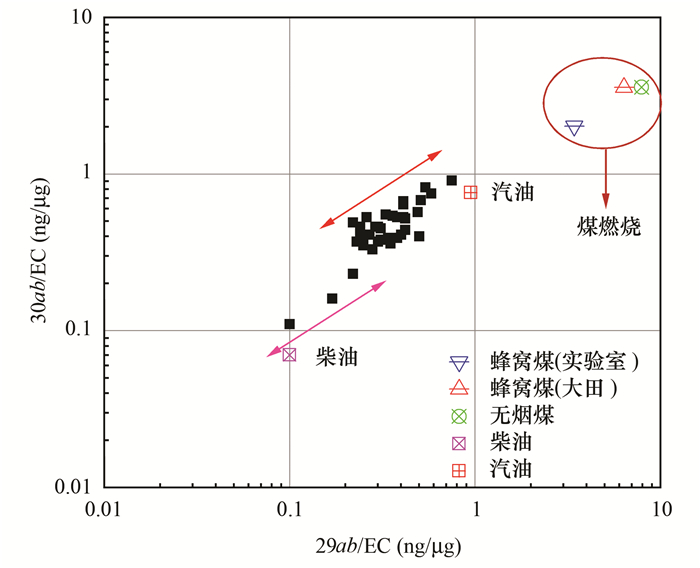
|
图 5 两种藿烷类化合物(29ab和30ab)在EC归一化下的比值 Fig. 5 Ratio-ratio plot of two kinds of hopanes (29ab and 30ab) normalized by EC |
为明确各排放源对该地区PM2.5中非极性有机化合物的相对贡献, 采用SPSS 19.0对各组分进行主成分分析, 根据特征值大于1的提取原则得到了3个因子, 累计贡献率达到了86.63%, 可以反映原始数据的多数信息, 正交旋转因子荷载矩阵结果见表 3.
|
|
表 3 2016年长春秋季PM2.5中正构烷烃、多环芳烃、藿烷组分的旋转矩阵 Table 3 Rotational matrix of n-alkanes, PAHs, and hopanes in PM2.5 in autumn in Changchun, 2016 |
因子1解释了34.84%的变量, 其中Phe和Flua等低分子量多环芳烃的负荷在因子1中最高, 且在因子2和因子3中的负荷均小于或等于0.1. Mastral等[51]和Khalili等[52]对煤和炼焦炉在不同燃烧条件下多环芳烃的排放特征进行了研究, 结果强调了Phe和Flua等低分子量多环芳烃占优势的特征, 证实了因子1主要来源于煤燃烧源.而长春市每年的供暖时间是从10月25日至次年4月10日, 表明供暖原因导致的煤燃烧源排放对本研究有机气溶胶有较大的贡献率.因子2解释了总方差的31.9%, 在这个因子里levoglucosan(左旋葡聚糖)的负荷占主导优势, 达0.92.而左旋葡聚糖是生物质燃烧显著的标志物[13, 14], 因此因子2主要来源于生物质燃烧.因子3中藿烷类化合物的因子负载系数最高, 据前文分析, 藿烷主要来自于机动车尾气, 因此表明因子3是来源于交通源的贡献.
以标准化后的物质浓度总和为因变量, 以表 3中3个主因子为自变量进行多元线性回归得到如下回归方程:

|
(3) |
式中, Fi为源i的因子得分变量, 拟合优度R2为0.82, 显著性水平α=0.05, P检验值为0.011 < 0.05.经式(1)计算各源贡献率分别为燃煤源47.0%、生物质燃烧源42.6%和交通源10.4%.
4 结论(1) 2016年长春秋季PM2.5平均浓度为(79.0±55.7) μg·m-3, 是国家环境空气质量日平均二级标准浓度限值的1.05倍, 污染天气PM2.5平均浓度是清洁天气的3.0倍. OC和EC平均质量浓度依次为(20.7±15.6) μg·m-3和(2.2±1.1) μg·m-3, 分别占PM2.5的26.2%和2.8%.两者的比值结果(4.2~20.6)表明采样点附近主要受到生物质燃烧源和煤燃烧源的影响, 交通源的贡献最小.
(2) PM2.5样品中定量分析的非极性有机化合物主要包括正构烷烃、多环芳烃以及藿烷类化合物, 三者的浓度大小表现为:正构烷烃[(101.3±67.0)ng·m-3]>多环芳烃[(81.4±46.0)ng·m-3]>藿烷类化合物[(3.8±1.9)ng·m-3].正构烷烃的CPI均值反映了人为源和生物源的共同作用, 而植物蜡含量%WaxCn则进一步证实该地区正构烷烃受生物源的影响更大; 多环芳烃的诊断率结果证实了煤燃烧源、生物质燃烧源以及交通源3个来源的影响; 升藿烷的异构化指标以及与EC的归一化比值表明汽油动力车是藿烷类化合物的主要排放源.
(3) PCA-MLR模型结果表明,该地区有机气溶胶排放源的相对贡献大小依次是:煤燃烧源(47.0%)>生物质燃烧源(42.6%)>交通源(10.4%).相关研究结果对我国东北城郊开展有机气溶胶的污染特征、来源的深入探讨以及防治措施提供一定的基础支撑.
| [1] |
郭新彪, 魏红英. 大气PM2.5对健康影响的研究进展[J]. 科学通报, 2013, 58(13): 1171-1177. Guo X B, Wei H Y. Progress on the health effects of ambient PM2.5 pollution[J]. Chinese Science Bulletin, 2013, 58(13): 1171-1177. |
| [2] | Matsumoto H, Inoue K. Mutagenicity of a polar portion in the neutral fraction separated from organic extracts of airborne particulates[J]. Archives of Environmental Contamination and Toxicology, 1987, 16(4): 409-416. DOI:10.1007/BF01055261 |
| [3] | Kleefeld S, Hoffer A, Krivácsy Z, et al. Importance of organic and black carbon in atmospheric aerosols at Mace Head, on the west coast of Ireland (53°19'N, 9°54'W)[J]. Atmospheric Environment, 2002, 36(28): 4479-4490. DOI:10.1016/S1352-2310(02)00346-1 |
| [4] | Ji Y M, Zhao J, Terazono H, et al. Reassessing the atmospheric oxidation mechanism of toluene[J]. Proceedings of the National Academy of Sciences of the United States of America, 2017, 114(31): 8169-8174. DOI:10.1073/pnas.1705463114 |
| [5] | Ng N L, Kroll J H, Chan A W H, et al. Secondary organic aerosol formation from m-xylene, toluene, and benzene[J]. Atmospheric Chemistry and Physics, 2007, 7(14): 3909-3922. DOI:10.5194/acp-7-3909-2007 |
| [6] | Turpin B J, Saxena P, Andrews E. Measuring and simulating particulate organics in the atmosphere:problems and prospects[J]. Atmospheric Environment, 2000, 34(18): 2983-3013. DOI:10.1016/S1352-2310(99)00501-4 |
| [7] | Pope Ⅲ C A, Burnett R T, Thun M J, et al. Lung cancer, cardiopulmonary mortality, and long-term exposure to fine particulate air pollution[J]. The Journal of the American Medical Association, 2002, 287(9): 1132-1141. DOI:10.1001/jama.287.9.1132 |
| [8] | Yu J Z, Huang X H H, Ho S S H, et al. Nonpolar organic compounds in fine particles:quantification by thermal desorption-GC/MS and evidence for their significant oxidation in ambient aerosols in Hong Kong[J]. Analytical and Bioanalytical Chemistry, 2011, 401(10): 3125-3139. DOI:10.1007/s00216-011-5458-5 |
| [9] | Schnelle-Kreis J, Orasche J, Abbaszade G, et al. Application of direct thermal desorption gas chromatography time-of-flight mass spectrometry for determination of nonpolar organics in low-volume samples from ambient particulate matter and personal samplers[J]. Analytical and Bioanalytical Chemistry, 2011, 401(10): 3083-3094. DOI:10.1007/s00216-011-5429-x |
| [10] | Simoneit B R T, Kobayashi M, Mochida M, et al. Composition and major sources of organic compounds of aerosol particulate matter sampled during the ACE-Asia campaign[J]. Journal of Geophysical Research:Atmospheres, 2004, 109(D19): D19S10. |
| [11] | del Rosario Sienra M, Rosazza N G, Préndez M. Polycyclic aromatic hydrocarbons and their molecular diagnostic ratios in urban atmospheric respirable particulate matter[J]. Atmospheric Research, 2005, 75(4): 267-281. DOI:10.1016/j.atmosres.2005.01.003 |
| [12] | Rogge W F, Hildemann L M, Mazurek M A, et al. Sources of fine organic aerosol. 2. Noncatalyst and catalyst-equipped automobiles and heavy-duty diesel trucks[J]. Environmental Science & Technology, 1993, 27(4): 636-651. |
| [13] | Fraser M P, Lakshmanan K. Using levoglucosan as a molecular marker for the long-range transport of biomass combustion aerosols[J]. Environmental Science & Technology, 2000, 34(21): 4560-4564. |
| [14] | Schauer J J, Kleeman M J, Cass G R, et al. Measurement of emissions from air pollution sources. 3. C1-C29 organic compounds from fireplace combustion of wood[J]. Environmental Science & Technology, 2001, 35(9): 1716-1728. |
| [15] |
刁格乐, 鲍秋阳, 马玉芹. 东北地区吉林市大气PM2.5中有机物及重金属的污染特征研究[J]. 东北师大学报(自然科学版), 2018, 50(3): 147-156. Diao G L, Bao Q Y, Ma Y Q. Research on the PM2.5 characteristics of organic matters and heavy metals pollution in Jilin, the Northeast of China[J]. Journal of Northeast Normal University (Natural Science Edition), 2018, 50(3): 147-156. |
| [16] |
陆建衡, 黄艺, 王春宇, 等. 吉林永安煤矿区土壤及近地表大气尘重金属污染评价[J]. 工业安全与环保, 2018, 44(6): 5-9, 21. Lu J H, Huang Y, Wang C Y, et al. Evaluation of heavy metals pollution to soil and air dust near ground of Yong'an coal mining area in Jilin[J]. Industrial Safety and Environmental Protection, 2018, 44(6): 5-9, 21. DOI:10.3969/j.issn.1001-425X.2018.06.002 |
| [17] |
鲍秋阳, 王毅勇, 张学磊, 等. 吉林市大气PM2.5污染特征及来源分析[J]. 环境保护科学, 2018, 44(3): 74-79. Bao Q Y, Wang L Y, Zhang X L, et al. Analysis of the characteristics and sources of atmospheric PM2.5 pollution in Jilin City[J]. Environmental Protection Science, 2018, 44(3): 74-79. |
| [18] |
施云芬, 刘月华, 李英赞. 吉林市大气污染物浓度分布规律[J]. 环境与健康杂志, 2008, 25(4): 334-336. Shi Y F, Liu Y H, Li Y Z. Distribution regularity of air pollutant concentration in Jilin City[J]. Journal of Environment and Health, 2008, 25(4): 334-336. DOI:10.3969/j.issn.1001-5914.2008.04.015 |
| [19] |
崔俊峰, 李英华, 景丽洁, 等. 吉林市大气气溶胶中部分有机污染物的分析[J]. 化工科技, 2008, 16(1): 41-43. Cui J F, Li Y H, Jing L J, et al. Analysis of organic pollutants of atmospheric aerosols in Jilin City[J]. Science & Technology in Chemical Industry, 2008, 16(1): 41-43. DOI:10.3969/j.issn.1008-0511.2008.01.012 |
| [20] |
李英华, 景丽洁, 崔俊峰, 等. 吉林市大气中PM10和PAHs污染特征[J]. 辽宁城乡环境科技, 2007, 27(1): 43-44, 52. Li Y H, Jing L J, Cui J F, et al. Pollution specialities of PM10 and PAHs in atmospheric environment in Jilin[J]. Liaoning Urban and Rural Environmental Science & Technology, 2007, 27(1): 43-44, 52. DOI:10.3969/j.issn.1674-1021.2007.01.016 |
| [21] |
李成日, 崔俊峰, 李英华, 等. 吉林市工业区大气可吸入颗粒物中多环芳烃的分布特征研究[J]. 吉林化工学院学报, 2005, 22(4): 16-18. Li C R, Cui J F, Li Y H, et al. Study on distribution characteristics of PAHs in inhalable particles in industry area in Jilin City[J]. Journal of Jilin Institute of Chemical Technology, 2005, 22(4): 16-18. DOI:10.3969/j.issn.1007-2853.2005.04.006 |
| [22] |
张振斌.长春市某城区气溶胶浓度特征及重金属化学形态分布研究[D].长春: 吉林大学, 2013. Zhang Z B. Study on the characteristics of concentration and distribution of heavy metals chemical speciation of aerosol in a district of Changchun[D]. Changchun: Jilin University, 2013. |
| [23] | Birch M E, Cary R A. Elemental carbon-based method for monitoring occupational exposures to particulate diesel exhaust[J]. Aerosol Science and Technology, 1996, 25(3): 221-241. DOI:10.1080/02786829608965393 |
| [24] |
周敏, 陈长虹, 王红丽, 等. 上海秋季典型大气高污染过程中有机碳和元素碳的变化特征[J]. 环境科学学报, 2013, 33(1): 181-188. Zhou M, Chen C H, Wang H L, et al. The variation characteristics of organic and element carbon during air pollution episodes in autumn in Shanghai, China[J]. Acta Scientiae Circumstantiae, 2013, 33(1): 181-188. |
| [25] |
魏巧珍, 王宇红, 李盛, 等. 基于PCA-MLR模型的兰州市大气PM2.5污染来源解析[J]. 环境卫生学杂志, 2017, 7(4): 267-273. Wei Q Z, Wang Y H, Li S, et al. The source apportionment of PM2.5 based on PCA-MLR model in Lanzhou City[J]. Journal of Environmental Hygiene, 2017, 7(4): 267-273. |
| [26] |
边璐, 李田, 侯娟. PMF和PCA/MLR法解析上海市高架道路地表径流中多环芳烃的来源[J]. 环境科学, 2013, 34(10): 3840-3846. Bian L, Li T, Hou J. Source apportionment of polycyclic aromatic hydrocarbons using two mathematical models for runoff of the Shanghai elevated inner highway, China[J]. Environmental Science, 2013, 34(10): 3840-3846. |
| [27] | Duan J C, Tan J H, Wang S L, et al. Roadside, urban, and rural comparison of size distribution characteristics of PAHs and carbonaceous components of Beijing, China[J]. Journal of Atmospheric Chemistry, 2012, 69(4): 337-349. DOI:10.1007/s10874-012-9242-5 |
| [28] | He L Y, Hu M, Huang X F, et al. Measurement of emissions of fine particulate organic matter from Chinese cooking[J]. Atmospheric Environment, 2004, 38(38): 6557-6564. DOI:10.1016/j.atmosenv.2004.08.034 |
| [29] | Schauer J J, Kleeman M J, Cass G R, et al. Measurement of emissions from air pollution sources. 5. C1-C32 organic compounds from gasoline-powered motor vehicle[J]. Environment Science & Technology, 2002, 36(6): 1169-1180. |
| [30] | Chen Y J, Zhi G R, Feng Y L, et al. Measurements of emission factors for primary carbonaceous particles from residential raw-coal combustion in China[J]. Geophysical Research Letters, 2006, 33(20): L20815. DOI:10.1029/2006GL026966 |
| [31] | Turpin B J, Cary R A, Huntzicker J J. An in situ, time-resolved analyzer for aerosol organic and elemental carbon[J]. Aerosol Science and Technology, 1990, 12(1): 161-171. DOI:10.1080/02786829008959336 |
| [32] |
李杏茹, 白羽, 陈曦, 等. 北京冬季重污染过程大气细颗粒物化学组成特征及来源分析[J]. 环境化学, 2018, 37(11): 2397-2409. Li X R, Bai Y, Chen X, et al. Chemical composition and source apportionment of PM2.5 during winter in Beijing[J]. Environmental Chemistry, 2018, 37(11): 2397-2409. DOI:10.7524/j.issn.0254-6108.2018011401 |
| [33] |
徐足飞, 曹芳, 高嵩, 等. 南京北郊秋季PM2.5碳质组分污染特征及来源分析[J]. 环境科学, 2018, 39(7): 3033-3041. Xu Z F, Cao F, Gao S, et al. Characteristics and source analysis of carbonaceous components of PM2.5 during autumn in the northern suburb of Nanjing[J]. Environmental Science, 2018, 39(7): 3033-3041. |
| [34] |
鞠法帅, 王鑫彤, 韩德文, 等. 金华地区PM2.5中的极性有机示踪物[J]. 环境科学学报, 2017, 37(8): 3054-3064. Ju F S, Wang X T, Han D W, et al. Polar organic tracers in PM2.5 in Jinhua[J]. Acta Scientiae Circumstantiae, 2017, 37(8): 3054-3064. |
| [35] | Feng J L, Hu M, Chan C K, et al. A comparative study of the organic matter in PM2.5 from three Chinese megacities in three different climatic zones[J]. Atmospheric Environment, 2006, 40(21): 3983-3994. DOI:10.1016/j.atmosenv.2006.02.017 |
| [36] | Simoneit B R T. Organic matter of the troposphere-Ⅲ:characterization and sources of petroleum and pyrogenic residues in aerosols over the western United States[J]. Atmospheric Environment, 1984, 18(1): 51-67. DOI:10.1016/0004-6981(84)90228-2 |
| [37] |
袁杨森, 刘大锰, 车瑞俊, 等. 北京夏季大气颗粒物中有机污染源的生物标志物示踪[J]. 中国科学院研究生院学报, 2007, 24(5): 601-611. Yuan Y S, Liu D M, Che R J, et al. Source tracing of biomarkers in the organic pollutants from atmospheric particulates in Beijing city during summer[J]. Journal of the Graduate School of the Chinese Academy of Sciences, 2007, 24(5): 601-611. DOI:10.3969/j.issn.1002-1175.2007.05.009 |
| [38] |
姚利, 李杏茹, 郭雪清, 等. 2007年春节期间北京大气细粒子中正构烷烃的污染特征[J]. 环境科学, 2009, 30(2): 589-593. Yao L, Li X R, Guo X Q, et al. Pollution characteristics of n-alkanes in atmospheric fine particles during spring festival of 2007 in Beijing[J]. Environmental Science, 2009, 30(2): 589-593. DOI:10.3321/j.issn:0250-3301.2009.02.046 |
| [39] | Alves C, Pio C, Duarte A. Composition of extractable organic matter of air particles from rural and urban Portuguese areas[J]. Atmospheric Environment, 2001, 35(32): 5485-5496. DOI:10.1016/S1352-2310(01)00243-6 |
| [40] |
赵文昌, 程金平, 谢海赟, 等. 环境中多环芳烃(PAHs)的来源与监测分析方法[J]. 环境科学与技术, 2006, 29(3): 105-107. Zhao W C, Chen J P, Xie H Y, et al. PAHs:Sources, pathway and their monitoring and analysis[J]. Environmental Science & Technology, 2006, 29(3): 105-107. DOI:10.3969/j.issn.1003-6504.2006.03.042 |
| [41] | Pistikopoulos P, Wortham H M, Gomes L, et al. Mechanisms of formation of particulate polycyclic aromatic hydrocarbons in relation to the particle size distribution; effects on meso-scale transport[J]. Atmospheric Environment. Part A. General Topics, 1990, 24(10): 2573-25841. DOI:10.1016/0960-1686(90)90135-A |
| [42] | Katsoyiannis A, Sweetman A J, Jones K C. PAH molecular diagnostic ratios applied to atmospheric sources:a critical evaluation using two decades of source inventory and air concentration data from the UK[J]. Environmental Science & Technology, 2011, 45(20): 8897-8906. |
| [43] | Yunker M B, Macdonald R W, Vingarzan R, et al. PAHs in the Fraser River basin:a critical appraisal of PAH ratios as indicators of PAH source and composition[J]. Organic Geochemistry, 2002, 33(4): 489-515. DOI:10.1016/S0146-6380(02)00002-5 |
| [44] | Akyüz M, Çabuk H. Gas-particle partitioning and seasonal variation of polycyclic aromatic hydrocarbons in the atmosphere of Zonguldak, Turkey[J]. Science of the Total Environment, 2010, 408(22): 5550-5558. DOI:10.1016/j.scitotenv.2010.07.063 |
| [45] | Ravindra K, Sokhi R, Van Grieken R. Atmospheric polycyclic aromatic hydrocarbons:source attribution, emission factors and regulation[J]. Atmospheric Environment, 2008, 42(13): 2895-2921. DOI:10.1016/j.atmosenv.2007.12.010 |
| [46] | Cass G R. Organic molecular tracers for particulate air pollution sources[J]. TrAC Trends Analytical Chemistry, 1998, 17(6): 356-366. DOI:10.1016/S0165-9936(98)00040-5 |
| [47] | Robinson A L, Donahue N M, Rogge W F. Photochemical oxidation and changes in molecular composition of organic aerosol in the regional context[J]. Journal of Geophysical Research:Atmospheres, 2006, 111(D3): D03302. |
| [48] | Robinson A L, Subramanian R, Donahue N M, et al. Source apportionment of molecular markers and organic aerosol-1. Polycyclic aromatic hydrocarbons and methodology for data visualization[J]. Environmental Science & Technology, 2006, 40(24): 7803-7810. |
| [49] | He L Y, Hu M, Zhang Y H, et al. Fine particle emissions from on-road vehicles in the Zhujiang Tunnel, China[J]. Environmental Science & Technology, 2008, 42(12): 4461-4466. |
| [50] | Zhang Y X, Schauer J J, Zhang Y H, et al. Characteristics of particulate carbon emissions from real-world Chinese coal combustion[J]. Environmental Science & Technology, 2008, 42(14): 5068-5073. |
| [51] | Mastral A M, Callén M, Murillo R. Assessment of PAH emissions as a function of coal combustion variables[J]. Fuel, 1996, 75(13): 1533-1536. DOI:10.1016/0016-2361(96)00120-2 |
| [52] | Khalili N R, Scheff P A, Holsen T M. PAH source fingerprints for coke ovens, diesel and, gasoline engines, highway tunnels, and wood combustion emissions[J]. Atmospheric Environment, 1995, 29(4): 533-542. DOI:10.1016/1352-2310(94)00275-P |
 2019, Vol. 40
2019, Vol. 40



